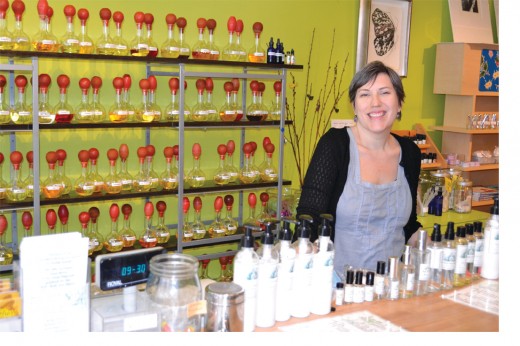District, merchants await half-cent tax impact

The U.S. Mint produced a half-cent coin from 1793 to 1857, finally discontinuing the coin when it cost more to make than it was worth and was considered too small to be useful. Leave it to modern politics to come up with a way to make the half-cent work again, not surprisingly in the form of a tax.
Community Improvement Districts — 160 of them — abound today in Missouri, and property owners in downtown Columbia last November approved a half-cent tax to be added to the existing 7.35 percent sales tax. Retail customers pay the tax beginning April 1.
The District of Columbia campaigned for the half-cent sales tax addition on the premise of providing enhanced downtown beautification, technology such as smart phone applications and Wi-Fi service, business marketing and development, event promotion and more entertainment and shopping venues.
 “I’m looking forward to seeing all the fun things we can do,” says Christina Kelley, owner of Makes Scents and a member of the Downtown Community Improvement District board. She said Columbia’s CID is essentially a merger of the goals of the Special Business District established in 1978 and the Central Columbia Association established in 1980.
“I’m looking forward to seeing all the fun things we can do,” says Christina Kelley, owner of Makes Scents and a member of the Downtown Community Improvement District board. She said Columbia’s CID is essentially a merger of the goals of the Special Business District established in 1978 and the Central Columbia Association established in 1980.
“One of the things this will do is to get everybody at the same table,” Kelley says referring to the varied interests — property owners, residents, business owners, shoppers and visitors — represented within the 43-block area ranging from the University of Missouri to Rogers Street and Providence Road to College Avenue. Property owners contribute to the District of Columbia through a special assessment added to their real estate taxes.
District officials say they’re not sure how much money the half-cent tax will bring in, as an initial projection of $350,000 in 2008 might not have been based on an accurate database, says Director Carrie Gartner. Nevertheless, the Special Business District is due to sunset in October after the replacement money begins to flow.
The district actively solicits input on how to spend its money, but comments to the office consistently favor cleaning and maintenance of the district, business advocacy, economic development and marketing and promotion.
Lack of retailers’ input
Although the CID itself was approved in 2011, the discussions have been going on for at least four years. Extensive opportunities for public comment were offered along the way, but a CBT sampling of downtown business owners found that many proprietors didn’t feel the need to attend the public meetings the district was required to hold as a Missouri public entity.
 “I would assume it [the tax] is in our best interests,” says Steve Dillard, proprietor of Tiger Spirit, a retail shop full of all things Mizzou. “That’s the change they’ve decided to do.” He said collecting the tax would not create any hassles and be merely a change in the sales tax setting on his cash register.
“I would assume it [the tax] is in our best interests,” says Steve Dillard, proprietor of Tiger Spirit, a retail shop full of all things Mizzou. “That’s the change they’ve decided to do.” He said collecting the tax would not create any hassles and be merely a change in the sales tax setting on his cash register.
As for any impact of the tax on downtown Columbia, Dillard was philosophical. “All these things you find out after the process starts … It will work itself out,” he says.
In any retail setting, changes may affect retailers differently. Consequently, there are widespread opinions on the best way to manage the downtown environment. One longtime resident who declined to be identified publicly alleged that the half-cent tax was designed to shift financial burdens from property owners to consumers and encourage the loss of retail shops in favor of professional offices.
“New always wins in this town,” he said, adding that the trend in retail is for customers to use the Internet, not shop downtown.
Retailer Laura Wilson, owner of Blackberry Exchange, said Columbia’s downtown has changed over the years, but she doesn’t see it as going downhill. “There’s always some current issue,” she says.
Roxsen Koch, an attorney with King Hershey in Kansas City who helped to draft the Community Improvement District enabling legislation, says she wasn’t aware of any instances where CID taxes have discouraged retail development. Most retail leases require tenants to pay special assessments and “retailers pass it on to shoppers,” Koch says.
Every other retail section in the city except for Business Loop 70 has a half-cent tax, Gartner says. Declining retail was the concern early last decade but recent statistics show retail is holding its own.
From 2010 to 2011, retail went from 23 percent to 27 percent of total businesses and office space went from 44 percent to 45 percent, Gartner says. Seven law offices were added during that time and one financial service was lost. But art galleries increased from nine to 41 with the addition of new studio complexes.
Downtown is also a great place for startup businesses, especially art galleries and other creative services, Gartner says. Small spaces provide locations at affordable rates on the second floor above shops, but startups often outgrow downtown and relocate elsewhere.
Parking problems
Parking in the District’s 5,900 available spaces is a popular topic of discussion, most recently over a pilot project testing use of high-tech kiosks that can take credit cards. The kiosks require users to enter a parking space number into the machine, which is located away from the parking space.
“I do think a huge asset of our location is the free and easy parking directly in front of our store,” says Justin Addison, owner of Tucker’s Fine Jewelry and Gift Gallery, located in a strip mall at Providence Road and Walnut Street. He says he’d like to see the half-cent tax go to reducing parking fees or “I’d like to see the money given back to the people who paid it.”
Arnie Fagan, owner of Cool Stuff, says the tax was sold as a way to make the District “clean and safe,” but complains he can’t get the District to clean up the alleyway behind his business where the city has a trash compactor. The District says the alley is the city’s responsibility.
Fagan also laments the loss of events such as the Twilight Festival, a once-a-week event that attracted many visitors to downtown. Gartner says the festival was shut down after 20 years because it was not serving the role it originally served and other festivals served the same audiences. “We now have an area where people want to come down every night,” she says.


